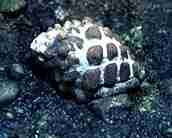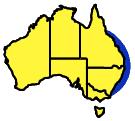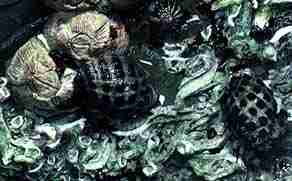|
|

Mulberry Whelk Morula marginalba
Form:
 The
Mulberry Whelk is a very easily identified shell with its spiral rows
of heavy, rounded nodules,
which give this shell its very distinctive "mulberry" appearance.
The
Mulberry Whelk is a very easily identified shell with its spiral rows
of heavy, rounded nodules,
which give this shell its very distinctive "mulberry" appearance.
It is more-or-less cone shaped on each end (biconic), but its low spire is just longer than the aperture length. It has a smooth and fairly straight columella.
Colour:
The shell is whitish-grey with very dark purple to black coloured tubercles, adding to its "mulberry-like" appearance. The outer lip yellowish. Deep inside the shell is blue-white, with a white columella.
Phylum: |
Mollusca |
Author: |
Blainville, 1832 |
Family: |
Muricidae |
Size: |
25-30 mm long |
Distribution:
 The
Mulberry Whelk ranges from central Queensland to southern New South Wales.
The
Mulberry Whelk ranges from central Queensland to southern New South Wales.
Habitat:
It is abundant at most levels of of a rocky ocean shore, being especially so near limpets and surf-barnacles, upon which it preys.
It also is common in estuaries, where it preys on oysters. Here it is known as the Black Oyster Borer and is a hated pest of Oyster Farmers.
Adults shelter in crevices, while juveniles can be found under rock debris.
Biology:
 The
Mulberry Whelk, or Black Oyster Borer preys
constantly on other molluscs and barnacles.
The
Mulberry Whelk, or Black Oyster Borer preys
constantly on other molluscs and barnacles.
It is able to bore a neat hole into their shell, and use its rasping tongue which is called a radula to cut up the animal and suck out the pieces. I measured one medium-sized Mulberry Whelk's radula at 8 cm long.
It is believed that the Mulberry Whelk is able to use a sulphuric acid from its salivary glands to dissolve and bore its way through the prey's limy shell. It is believed that this may only take two high tides.
References:
Bennett, I. (1987) W.J. Dakin's classic study: Australian Seashores. p. 291, Angus & Robertson, Sydney.
Davey, K. (1998) A Photographic Guide to Seashore Life of Australia. p.114, New Holland, Sydney.
Edgar, G.J. (1997) Australian Marine Life: the plants and animals of temperate waters. p.259, Reed Books, Kew.
Quinn, G.P., Wescott, G.C. & Synnot, R.N. (1992) Life on the Rocky Shores of South-Eastern Australia: an illustrated field guide. p.50, Victorian National Parks Association, Melbourne.
Underwood, A.J. & Chapman, M.G. (1993) Seashores: a beachcomber's guide. p.42, New South Wales University Press, Sydney.
Wilson, B.R. & Gillett, K. (1979) A field guide to Australian Shells: Prosobranch Gastropods. p.156, A.H. & A.W. Reed, Sydney
Home
Page
Taxonomy
Biogeography
Rocky Shores
Tidal Levels
Intertidal Zonation
Environmental Factors
Biological
Factors
Feeding Relationships
Activities
Glossary
References
 Life
on Australian Seashores
Life
on Australian Seashores
by Keith Davey (C) 2000
Learning Consultant
- Media
The University of Newcastle
email at australian_seashores@hotmail.com
Scientific Consultant: Phil
Colman
site created 01.01.98 : updated 01.04.2000